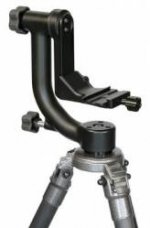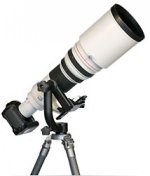I've just bought this well-known product as an upgrade for my Manfrotto 393 to go with a Nikon 600mm. Having set it up out of the box, it is very impressive indeed. I have three specific remarks, to compare both heads, and some final comments:
1.
To second Andy's comments, the gimbal has both vertical and horizontal adjustment for perfect balance (unlike the Manfrotto, with just horizontal adjustment along the lens plate) and this makes it balance at any angle even when the knobs are not tightened the Manfrotto cannot do this. It works perfectly if you take the time to read the instructions and set it up correctly - though it's recommended you mark the positions of the horizontal and the vertical adjustments with a pen so that you can easily relocate the balance point each time you set up the lens on the head.
The reason this is important is that the balanced Wimberley setup puts less stress on the tightening knob to hold the lens in place; on the Manfrotto this is fine if your lens is relatively lightweight (I used it very happily with my original Tamron 200-500mm), but if you move to a supertele prime, and therefore multiply the weight supported considerably (the Tamron weighs just over 1kg; Nikon 600VR is just over 5kg), the Manfrotto begins to struggle to hold the weight, meaning that there is some play even if the knobs are tightly locked down, resulting in some movement in the viewfinder.
2.
The Wimberley also has a panning control knob, which the Manfrotto lacks. This prevents sideways panning play when you want the head to be locked down. It also means that you can lock down the head when you are carrying it over the shoulder (though if youre using a Gitzo tripod, make sure the top-plate bolt is tight!), so that the lens wont move on the tripod on its own.
3.
Modular add-ons: the head comes with a product catalogue listing a full range of accessories you can add to the head. Most useful are likely to be flash brackets, which attach neatly to the top of the vertical arm, to raise the flash gun away from the lens axis. These are pricey, but unless you fabricate something yourself, theres no support for this with the Manfrotto 393.
Final comments.
An excellent piece of kit. Anyone contemplating buying this will probably already have a decent tripod, which is a must. The Wimberley head is 4x more expensive than the Manfrotto, which is a bit of an issue, but if youve shelled out for a 500-600mm prime (or indeed a 300-800 Sigma), then youll need a solid leg and head set. The advantages over the Manfrotto 393 might seem subtle - they weigh about the same, and are about the same size - but if you have the opportunity to play around with both, the advantages of the Wimberley are clear.
The head uses the Arca-Swiss style quick release plate system; if youre with Nikon youll need the replacement Wimberley foot (AP-452 for the 600VR, AP-553 for 500VR), though youll probably want this anyway since the stock Nikon 600mm foot, at least, is lousy.
If youve got serious about your birding lens, and have gone for a 500mm or 600mm prime, or the Sigma 300-500mm, this works great. The lower the lens weight, the more the Manfrotto comes back into the equation; however, if your lens is a 300f2.8, or perhaps Nikons 200-400VR, the full Wimberley will probably still be for you.





